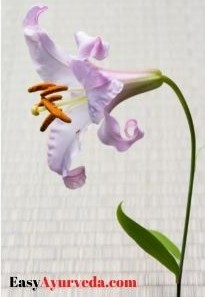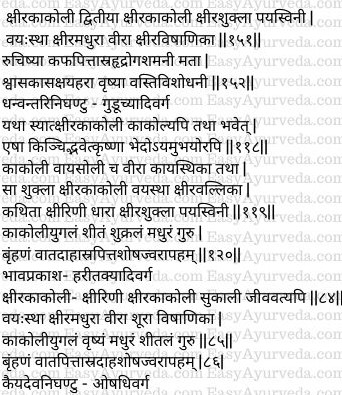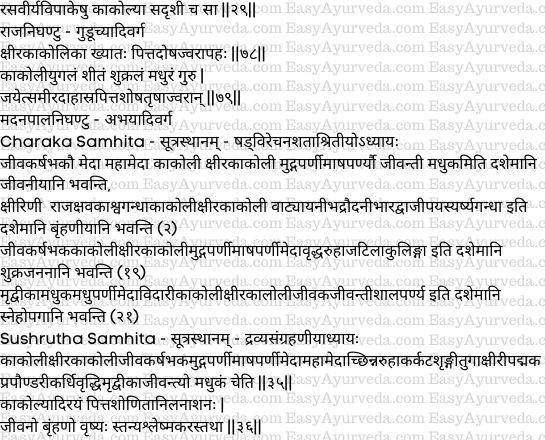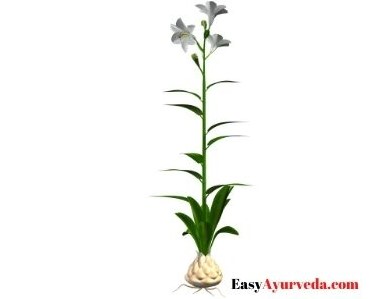Kshirakakoli (Lilium polyphyllum) Uses, Medicinal Qualities, Research
By Dr Renita D’Souza
Kshirakakoli is one among the list of endangered medicinal herbs, commonly known as Himalayan Lilly. The ancient science of medicine, Ayurveda recommends the usage of bulbs of Ksheerakakoli to treat general debility, rheumatism, bleeding disorders, fever, bronchitis and other such diseases which are mainly related to Vata and Pitta dosha.
Botanical Name – Lilium polyphyllum
Synonyms
Lilium punctatum Jacquem. ex Duch
Lilium polyphyllum var. uniflorum Boiss
Family – Liliaceae
Read – Vidarikand Pueraria tuberosa Uses, Research, Side Effects

Table of Contents
Vernacular Names Of Kakoli
English Name – White Himalaya Lily, Many-leaved lily
Sanskrit Name – Kshirakakoli
Hindi Name – Kalihari, Kshirakakoli
Kannada Name – Ksirakakoli
Malayalam Name – Kseerakakoli
Tamil Name – Ksirakakoli
Telugu Name – Ksirakakoli
Medicinal Qualities
Taste – Sweet
Virya – Cold – Sheeta
Vipaka (taste after digestion) – Sweet
Guna
Guru – heavy for digestion
Brimhana – nourishes the body tissue
Action (Karma)
Shukrala – increases sperm count
Vrishya – Aphrodisiac
Basti vishodini – cleanses urinary tract problems
Jivana – enlivening
Sthanyakara – increases breast milk (Galactagogue)
Read – Shukrajanana Gana: Herbs To Improve Semen, Sperm: Review, Formulations
Effect on Tridosha
Balances Vata and Pitta dosha
Therapeutic Uses
Asra roga – Blood disorders
Hridroga – Cardiac diseases
Shwasa – Asthma, Difficulty in breathing
Kasa – Cough
Kshya – Emaciation
Vata roga – Diseases of Vata dosha origin
Daha – Burning sensation
Shosha – Tissue depletion
Jwara – Fever
Trishna – Excessive thirst
Part Used
Underground bulbs
Dosage
Bulb powder – 3-6 grams
Sanskrit Verses


Read – Gajakarna – Uses, Benefits, Qualities, Remedies, Research
Remedies
Dry roasted Kshirakakoli used in emaciation and acts as a good energy booster.
Nutritional Values
Lilium polyphyllum contains sugar, alkaloid, flavonoids and steroids. (D)
Pharmacological Activity
Lilium polyphyllum bulbs are Galactagogue, Expectorant, Aphrodisiac, Diuretic, Antipyretic, Soothing and shows anti-inflammatory properties. (Read more)

Botanical Description
Lilium polyphyllum is a perennial bulbous herb. Stem is hallow, grows up to 1 meter in height. Leaves are fleshy, sessile, lanceolate in shape with acuminate tip and parallel venation. Flowers are large, fragrant with 5 tepals which are creamish or dull yellowish color outside and inside white along with purple streaks. Flower has 6 stamens. Fruit is oblong capsule with 3 longitudinal grooves. Capsule contains over 100 brown seeds. Blubs look externally as an underground stem with fleshy, conical translucent scale leaves and roots are attached to the basal plate. (B)
Distribution
Lilium polyphyllum is found in Himalaya, Tibet, Nepal, Pakistan, Wanga Valley in the Northwestern Himalaya Mountains, Hunza Valley of Pakistan, West China and Afghanistan. In India it is found in Jammu and Kashmir, Uttarakhand and Himachal Pradesh (A)
Habitat
Lilium polyphyllum grow in cold and temperate regions. (E)
Chemical Constituents
The bulb of Lilium polyphyllum contains linalool and α-terpineol. (C)
Controversy, Substitutions
Ksheerakakoli is one among the Ashtavarga dravyas. The work on identification of these Ashtavarga medicinal herbs has been done but the true representatives of these herbs is not yet known. These herbs are listed under endangered medicinal herbs. The substituents for these herbs are mentioned in Bhavaprakasha Nighantu, hence it is understood that these herbs were found very rare or extinct even earlier in around 15 – 16th century.
Read – Ashtavarga Group Of Herbs Benefits, Research
Substitutions used for Kshirakakoli
Ashvagandha (Withania somnifera) is used as substitution for Kshirakakoli.
Other substitutions which are used in place of Kshirakakoli are
Safed musali (Chlorophytum arundinaceum),
Fritillaria roylei Hook.,
Fritillaria oxypetala D. Don and also
Lilium wallichianum Schult. & Schult. f.
Read – Spider Lily (Crinum asiaticum) Uses, Research, Remedies, Medicines
Classical categorization
Bhavaprakasha Nighantu – Haritakyadi varga
Madanapala Nighantu – Abhayaadi varga
Dhanvantari Nighantu – Guduchyadi varga
Raja Nighantu – Guduchyadi varga
Kaiyadeva Nighantu – Oashadi varga
Sushrutha Samhita – Kakolyadi Gana
Charaka Samhita mentioned Kakoli under Jivaniya dashemani, Brihmaniya, Shukrajananiya, Snehopaghaniya and Angamardaprashamana dashemani.
Sanskrit Synonyms
Kshirashukla, Payasvini, Vayahsthah, Kshiramadhura, Vira, Kshiravishanika
Kshiravallika, Kshirini, Dhara
Sukali, Jivavathyapi, Shura
Jivavalli, Jivashukla
Suravaha
Research
Anti-inflammatory Activity – A study conducted for analysis of phytochemical and anti inflammatory activity of Lilium polyphyllum have proved that the plant possess phytochemicals which are used as antiinflammatory.
Antidiabetic Activity – A study ” The Antidiabetic and Spectral Analysis of Various Extracts of Lilium Polyphyllum”, have concluded significant anti diabetic property of Lilium Polyphyllum.
Formulations using Kakoli
- Chyavanprash
- Dhanvantharam Mezhukupaakam – Best used in vata disorders, Puerperal and pediatric diseases.
- Shiva Gutika – Used in Liver and spleen disorders, respiratory problems, skin disorders, ascites etc
- Prasoothika kashaya – Helps to restore health after delivery (postpartum period)
- Dashamoolarishtam – Used in anemia, postpartum period, cough, digestive problems etc
- Jivanthyadi Ghrita – Used as medicine for Snehakarma, Netra basti and Netra tarpana. Treats glaucoma
- Amruth Jeevan Rasayan – Used to treat fatigue, low immune power, osteoporosis etc
- Madhuyashtyadi Taila – Used to treat pitta dosha related problems such as Fever, Burning sensation etc
- Brihat Guduchi Taila – Used in gout, skin diseases, diabetes, itching, burning sensation, liver diseases etc
Scientific Classification
Kingdom – Plantae
Clade – Tracheophytes
Clade – Angiosperms
Clade – Monocots
Order – Liliales
Family – Liliaceae
Subfamily – Lilioideae
Tribe – Lilieae
Genus – Lilium
Species – L. polyphyllum (A)
Click here to consult Dr Renita D’Souza









